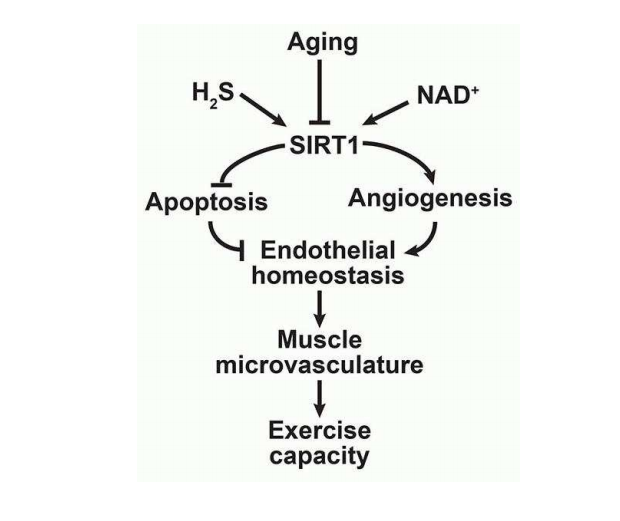[学术文献]内皮NAD+-H2S信号网络的损伤是血管老化的可逆原因
原文标题Impairment of an endothelial NAD+ -H2 S signaling network is a rev ersible cause of vascular aging
内皮NAD+-H2S信号网络的损伤是血管老化的可逆原因【PDF在线阅读/下载】
A. Das,1,7 G.X. Huang,2,3 A. Longchamp,4 L. Kim,1 C. Li,1 B. Osborne,5 S. Joshi,5 M. Kang,1 T. Hung,6 B. Lee,6 E.O. Williams,7 M. Igarashi,7 J.R. Mitchell,4 L.E. Wu,1 N. Turner,5 Z. Arany,3 L. Guarente7 and D.A. Sinclair,1,2 1Laboratory for Ageing Research, Department of Pharmacology, School of Medical Sciences, The University of New South Wales, NSW 2052, Australia, 2Glenn Center for the Biological Mechanisms of Aging, Department of Genetics, Harvard Medical School, Boston, MA 02115, USA, 3Smilow Center for Translational Research, Perelman School of Medicine, University of Pennsylvania, 3400 Civic Center Boulevard, Bldg. 421, Philadelphia, PA 19104, USA, 4Department of Genetics and Complex Diseases, Harvard T. H. Chan School of Public Health, Boston, MA, USA, 5Mitochondrial Bioenergetics Laboratory, Department of Pharmacology, School of Medical Sciences, The University of New South Wales, NSW 2052, Australia, 6Biological Resources Imaging Laboratory

The University of New South Wales, NSW 2052, Australia and 7Paul F. Glenn Center for Science of Aging Research, Department of Biology, Massachusetts Institute of Technology, Cambridge, MA 02139, USA. In skeletal muscle, endothelial cell dysfunction, impaired microcapillary formation and a progressive decline in exercise capacity are hallmarks of aging, yet the underlying causes are poorly understood. SIRT1, an NAD + -dependent protein deacylase, is a pro-longevity factor that mediates many of the health benefits of caloric restriction. Metabolic precursors of NAD+ have attracted attention for their ability to reverse the decline in NAD + during aging, improve health, and extend lifespan in mice. Here, we show that deletion of the SIRT1 gene specifically in endothelial cells results in an accelerated loss of capillary density and exercise capacity during aging along with an inability to respond to exercise. Conversely, overexpression of SIRT1 in endothelial cells increases capillary density and maintains the endurance capacity of old mice. Treatment of old mice with the NAD + precursor nicotinamide mononucleotide (NMN) restores NAD+ levels to those of young mice, with a concomitant SIRT1-dependent increase in muscle capillary formation and exercise capacity. Hydrogen sulfide gas (H2 S) extends lifespan in simple metazoans and is implicated in mediating the benefits of dietary restriction in mammals possibly by activating SIRT1. We show that co-treatment of NMN and the H2 S donor sodium hydrosulfide (NaHS) further improved the muscle capillary density and exercise capacity in aged mice by activation of endothelial SIRT1. These data indicate that a decline in endothelial SIRT1 activity underlies capillary loss in muscle and exercise capacity with aging, effects that appear to be reversible by raising levels of NAD + and H2 S in the endothelium.
内皮NAD+-H2S信号网络的损伤是血管老化的可逆原因【PDF在线阅读/下载】
A. Das,1,7 G.X. Huang,2,3 A. Longchamp,4 L. Kim,1 C. Li,1 B. Osborne,5 S. Joshi,5 M. Kang,1 T. Hung,6 B. Lee,6 E.O. Williams,7 M. Igarashi,7 J.R. Mitchell,4 L.E. Wu,1 N. Turner,5 Z. Arany,3 L. Guarente7 and D.A. Sinclair,1,2 1Laboratory for Ageing Research, Department of Pharmacology, School of Medical Sciences, The University of New South Wales, NSW 2052, Australia, 2Glenn Center for the Biological Mechanisms of Aging, Department of Genetics, Harvard Medical School, Boston, MA 02115, USA, 3Smilow Center for Translational Research, Perelman School of Medicine, University of Pennsylvania, 3400 Civic Center Boulevard, Bldg. 421, Philadelphia, PA 19104, USA, 4Department of Genetics and Complex Diseases, Harvard T. H. Chan School of Public Health, Boston, MA, USA, 5Mitochondrial Bioenergetics Laboratory, Department of Pharmacology, School of Medical Sciences, The University of New South Wales, NSW 2052, Australia, 6Biological Resources Imaging Laboratory

The University of New South Wales, NSW 2052, Australia and 7Paul F. Glenn Center for Science of Aging Research, Department of Biology, Massachusetts Institute of Technology, Cambridge, MA 02139, USA. In skeletal muscle, endothelial cell dysfunction, impaired microcapillary formation and a progressive decline in exercise capacity are hallmarks of aging, yet the underlying causes are poorly understood. SIRT1, an NAD + -dependent protein deacylase, is a pro-longevity factor that mediates many of the health benefits of caloric restriction. Metabolic precursors of NAD+ have attracted attention for their ability to reverse the decline in NAD + during aging, improve health, and extend lifespan in mice. Here, we show that deletion of the SIRT1 gene specifically in endothelial cells results in an accelerated loss of capillary density and exercise capacity during aging along with an inability to respond to exercise. Conversely, overexpression of SIRT1 in endothelial cells increases capillary density and maintains the endurance capacity of old mice. Treatment of old mice with the NAD + precursor nicotinamide mononucleotide (NMN) restores NAD+ levels to those of young mice, with a concomitant SIRT1-dependent increase in muscle capillary formation and exercise capacity. Hydrogen sulfide gas (H2 S) extends lifespan in simple metazoans and is implicated in mediating the benefits of dietary restriction in mammals possibly by activating SIRT1. We show that co-treatment of NMN and the H2 S donor sodium hydrosulfide (NaHS) further improved the muscle capillary density and exercise capacity in aged mice by activation of endothelial SIRT1. These data indicate that a decline in endothelial SIRT1 activity underlies capillary loss in muscle and exercise capacity with aging, effects that appear to be reversible by raising levels of NAD + and H2 S in the endothelium.

